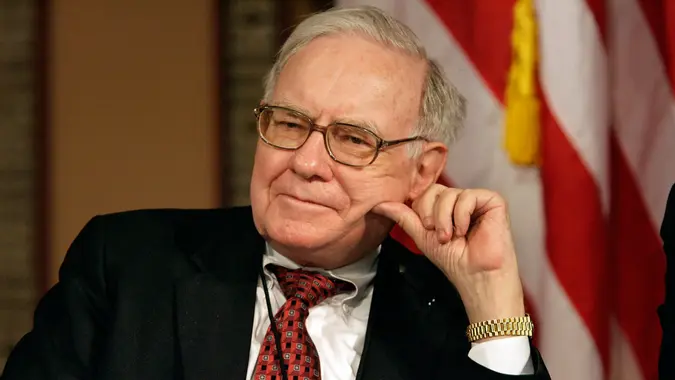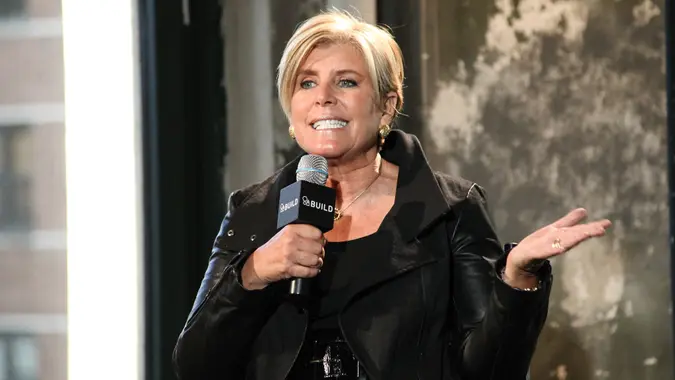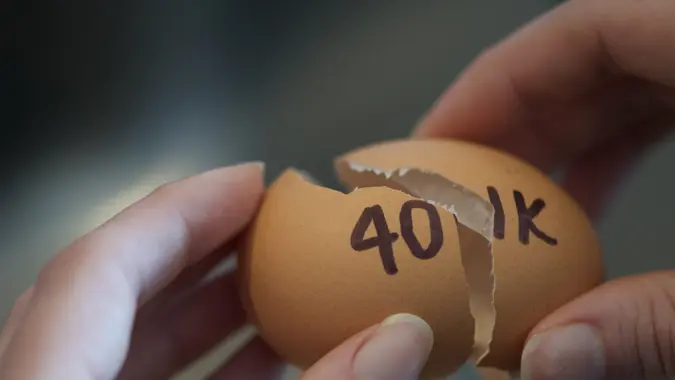Tariffs Could Cost the Average American Household Nearly $5K a Year, Study Finds

Commitment to Our Readers
GOBankingRates' editorial team is committed to bringing you unbiased reviews and information. We use data-driven methodologies to evaluate financial products and services - our reviews and ratings are not influenced by advertisers. You can read more about our editorial guidelines and our products and services review methodology.

20 Years
Helping You Live Richer

Reviewed
by Experts

Trusted by
Millions of Readers
An April 2025 study by The Budget Lab found that Americans now face an overall average effective tariff rate of 28%. That’s the highest import tax rate since 1901.
The bottom line: The average household will lose about $4,900 yearly in the short term, followed by long-term impact from slower economic growth, higher unemployment and high inflation.
Slower GDP Growth
The Budget Lab forecasts the Trump administration tariffs decreasing economic growth to 1.1 percentage points lower than the country would otherwise have experienced in 2025. In the long run, they predict the current high tariffs reducing annual GDP growth by 0.6 percentage points.
Sure enough, the economy is already flashing early warning signs. A survey by Collage Group found that 72% of Americans have changed their spending habits in response to tariffs. Specifically, they’re switching to discount or bulk retailers, adjusting their budgets — and ceasing to buy some things altogether.
Foreign tourism to the U.S. has also plummeted already. For example, Oxford Economics found a 32% collapse in Canadian visits to the U.S. through land borders in March, year-over-year.
Higher Unemployment
The Budget Lab study also predicts the unemployment rate rising 0.6 percentage points by the end of 2025. Specifically, that means a drop of 770,000 in payroll employment.
They’re not the only ones forecasting a sharp drop in employment. George Carrillo, CEO at the Hispanic Construction Council, says their firm has run some alarming numbers. “Job losses could reach 600,000 by year’s end as businesses grapple with disrupted supply chains and reduced consumer spending.”
Higher Food Prices
Tariffs drive up prices on imported goods, exacerbating inflation. And as much food as the U.S. produces, it also imports plenty of edible goods.
The analysis by The Budget Lab calculates that food prices overall will jump and stay 2.8% higher in the long-run. Fresh produce will particularly suffer, leaping 5.4% in the short term and stabilizing at 3.6% higher prices.
“Staples like avocados and tomatoes from Mexico are projected to go up 25%, adding hundreds to annual grocery costs,” Carrillo said.
Higher Auto Prices
Car prices exploded during and after the COVID-19 pandemic, and just when they had started resettling, import tariffs threw them back into turmoil.
The Budget Lab report forecasts auto prices rising 12% in the short-run and 15% in the long-run. The latter will add an extra $7,400 to the price of an average new car from last year.
Higher Apparel Costs
The U.S. imports most of its clothes from overseas. The report sees the sharpest jump in clothing and other apparel costs.
In particular, it projects prices skyrocketing 87% for leather products — shoes and hand bags — 65% for apparel and 45% for textiles.
Higher Costs for Home Improvement and Goods
Mike Fretto, creative director at Neighbor outdoor furniture, noted just how much lumber the U.S. imports, especially from Canada.
“This lumber is used for building homes and other buildings, for all kinds of different home improvement projects, for building furniture, and more,” he explained.
He’s not alone in that fear. Jeremy Yamaguchi serves as CEO of Cabana Pools and worries about how tariffs will impact all home improvement and construction projects. He listed lumber, cement and aluminum as examples of materials the U.S. imports.
“Some of the industry experts we’re talking to are expecting average home improvement projects to cost anywhere from 8%-15% more,” he said.
That says nothing of the potential drop in new construction starts. Builders only start projects when they’re confident they can sell for a significant profit over their costs. But when costs explode, it leaves many builders wary of launching new projects.
Will the current tariffs remain in place? Trade policy from the White House has certainly shifted fast over the last three months. Only time will tell what import taxes remain in place long-term — and whether these predictions will be proven true.
Editor’s note on political coverage: GOBankingRates is nonpartisan and strives to cover all aspects of the economy objectively and present balanced reports on politically focused finance stories. You can find more coverage of this topic on GOBankingRates.com.
More From GOBankingRates
Sources
- The Budget Lab, “State of U.S. Tariffs: April 15, 2025.”
- Collage Group, “Consumer Reactions to Tariffs and Price Increases.”
- Oxford Economics, “Inbound Travel to US in Steep Decline.”
- George Carrillo, Hispanic Construction Council
- Mike Fretto, Neighbor
- Jeremy Yamaguchi, Cabana Pools
 Written by
Written by  Edited by
Edited by 

























